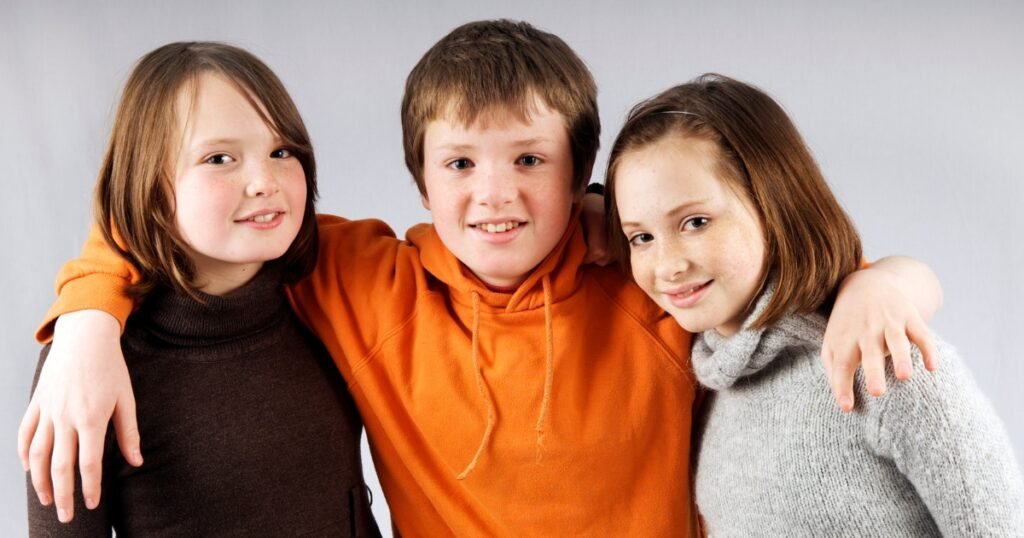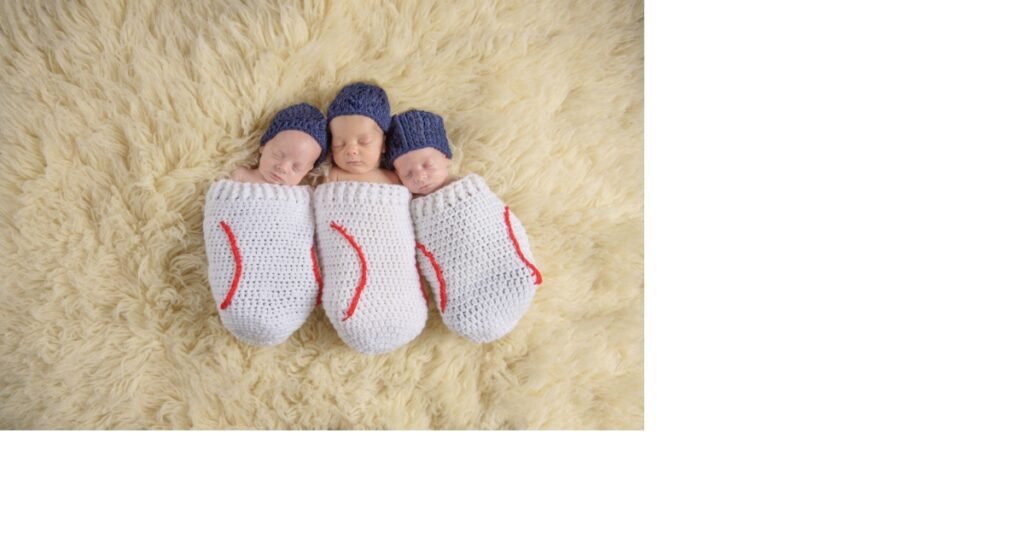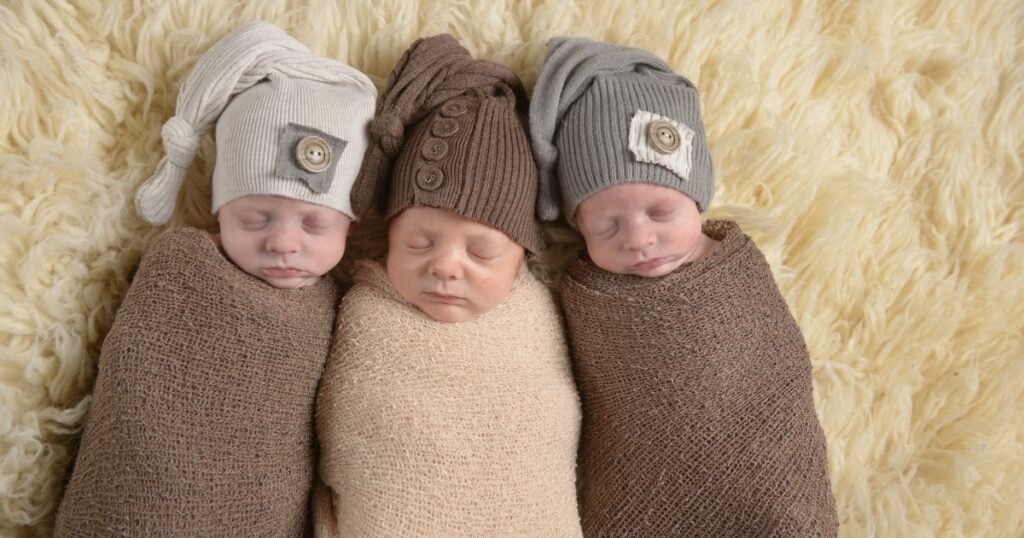Last Updated on 15 August 2024
Having triplets can be both thrilling and overwhelming for expectant parents. While twin pregnancies have become increasingly common due to factors like fertility treatments and maternal age, triplets remain a rare phenomenon, especially when conceived naturally and without medical intervention. But just how rare are triplets? What are the odds of having triplets naturally? What factors increase the likelihood of naturally conceiving three babies at once? In this blog, we will dive into the fascinating world of multiple births, exploring the odds of having triplets, the factors that influence this possibility, and what you need to know if you are dreaming (or bracing yourself) for a triplet pregnancy.
Understanding how triplets are conceived requires a closer look at the biology of multiple pregnancies. There are two main types of triplets: fraternal (dizygotic or trizygotic) and identical (monozygotic). Fraternal triplets occur when three separate eggs are fertilized by three different sperm cells, resulting in genetically unique siblings. On the other hand, identical triplets are formed when a single fertilized egg splits into three embryos, which is an exceptionally rare occurrence.
While rare, naturally occurring triplets happen, and certain factors can increase the likelihood. For instance, maternal age plays a significant role, as women in their 30s and 40s are more likely to release multiple eggs during ovulation. Additionally, your chances may be higher if you have a family history of multiples or have previously given birth to twins or triplets.
In the following sections, we will break down the statistics surrounding natural triplet pregnancies, discuss the genetic and environmental factors contributing to them, and explore what expectant parents can expect from a triplet pregnancy. Whether you’re curious about your odds or fascinated by the mysteries of human reproduction, this guide will provide insight into one of nature’s most intriguing phenomena: the journey of naturally conceiving triplets.
Understanding Triplets: An Overview
Triplets are three offspring born from a single pregnancy. They are less common than twins and can develop in a few different ways. The most common type is fraternal triplets, where three separate eggs are fertilized by three separate sperm. Like siblings born from separate pregnancies, each baby has its own placenta and amniotic sac. However, it is important to note that the mortality rate for multiples is higher than that for singletons, with stillbirth being more common among the general population.

A literary review on multiple pregnancies shows a study done on one set each of septuplets and octuplets, two sets of sextuplets, 8 sets of quintuplets, 17 sets of quadruplets, and 228 sets of triplets, highlighting the potential risk of complications associated with multiple births, specifically triplet births, and the use of assisted reproductive technology. Understanding the risks and odds of having triplets and the increased risk with each additional fetus is important for the general population to be aware of when considering starting a family.
Identical triplets are less common, but they are a remarkable occurrence stemming from a single fertilized egg. The fertilized egg splits in this scenario, creating three embryos with identical genetic material. Depending on when the egg splits, identical triplets may share a placenta or even an amniotic sac, increasing certain pregnancy risks.
The Basics of Triplet Pregnancy
Now, you might be thinking, “Three babies at once? Wowza!” And you are right, it is quite a journey! Imagine the excitement, the chaos (in the best way possible), and the triple dose of baby cuddles. But it is also a bit more complex than a single pregnancy.
Think of it this way: Your body works overtime to nourish and support three little humans. This means more frequent prenatal appointments, specialized care, and potentially a higher chance of certain complications, like preterm labor or low birth weight.
But hey, don’t let that scare you! With proper medical guidance and much love, triplet pregnancies can result in three healthy, happy babies.
Types of Triplets: Identical, Fraternal, and Mixed
Alright, let’s break down these triplet types a bit more. Identical triplets, as we’ve established, are like the rock stars of the multiples world—rare and extraordinary. They happen when that single fertilized egg goes “Surprise!” and splits into three.
On the other hand, fraternity triplets are more like siblings born simultaneously. Three separate eggs, three different sperm—each baby has its genetic blueprint. And get this: You can even have a mix! One egg splits (identical twins! ), and another egg joins the party (fraternal triplet!) Talk about a biological party trick.

The type of triplets you have also influences their appearance and whether they will be of the same sex. Pretty cool, right?
The Science Behind Natural Triplet Pregnancies
What exactly causes a woman’s body to release multiple eggs at once or for a single fertilized egg to split? While the exact mechanisms are complex, certain factors play a role. Genetics, age, and even environmental influences can increase the likelihood of these events.
Understanding these factors helps us grasp the reasons behind the remarkable occurrence of natural triplet pregnancies, shedding light on the fascinating world of human reproduction.
Genetic Factors Influencing Triplet Births
You know how people say, “It runs in the family”? Well, that rings true for fraternal triplets! If there’s a history of fraternal twins or triplets in your family or your partner’s family (especially on the mother’s side), your chances of having fraternal triplets naturally increase.
It’s all about those genes! Specific genes can make a woman prone to releasing multiple eggs during ovulation, increasing the odds of multiple fertilizations. However, keep in mind that identical triplets are a different story.
Remember, identical triplets happen when a single fertilized egg divides. It’s a random occurrence—a beautiful quirk of biology—and isn’t directly linked to family history.
Environmental and Lifestyle Factors
Beyond family history, lifestyle, and environmental factors might play a subtle role, though research in this area is ongoing. Some studies suggest that diet, geographic location, and even exposure to certain chemicals could influence the chances of multiples.
For instance, some speculate that diets rich in yams, which contain a compound that may stimulate ovulation, could increase the odds. Also, certain regions of the world report slightly higher twinning rates, hinting at potential environmental influences.
It is important to note that while these factors are interesting to consider, more research is needed to establish definitive links. Reproductive technology, like in vitro fertilization, has significantly contributed to the rise in multiple births, including triplets, in recent decades.
Odds and Statistics: What are the odds of having triplets naturally
Natural triplet pregnancies, without the help of fertility treatments, are genuinely uncommon. The American Society of Reproductive Medicine estimates that triplets occur in about 1 in every 8,000–10,000 pregnancies conceived without medical assistance.
These odds make natural triplets a relatively rare phenomenon, sparking both curiosity and intrigue when they occur.
Comparing Odds: Twins vs. Triplets
Let’s put those triplet odds into perspective! Compared to twins, triplets are far less common. You’re more likely to encounter a set of twins pushing a stroller than stumble upon a trio of triplets.
Think about it like this: for every 100 sets of twins born, you might find just one set of triplets—maybe. So, statistically speaking, those triple strollers are a much rarer sight.
But hey, that makes encountering a set of triplets all the more remarkable, right? It’s a testament to the incredible natural variations in human reproduction.
Recent Trends in Triplet Birth Rates in the United States
Interestingly, triplet birth rates in the United States increased significantly from the 1980s to the late 1990s, largely due to the increased use of fertility treatments. However, from the late 1990s onward, the triplet birth rate started declining.
This decline is likely due to increased awareness among healthcare providers regarding the risks associated with multiple births from fertility treatments and a shift towards transferring fewer embryos during in vitro fertilization procedures.
| Year | Triplet Birth Rate (per 100,000 live births) |
| 1980 | 37.1 |
| 1990 | 105.5 |
| 2000 | 182.5 |
| 2010 | 102.6 |
| 2020 | 81.4 |
Health Considerations for Triplet Pregnancies
While triplet pregnancies are an incredible feat of nature, they pose unique challenges. Increased risks to both the mother and babies mean a heightened need for specialized medical care throughout the pregnancy, delivery, and postpartum period.
Monitoring and managing these potential complications is crucial to ensuring a healthier outcome for both mother and babies.
Risks and Complications in Triplet Pregnancies
Triplet pregnancies fall into the “high-risk” category, meaning there’s a greater chance of certain complications compared to single pregnancies. These complications can include preterm labor, gestational diabetes, pre-eclampsia, and low birth weight.
Premature birth, occurring before 37 weeks of pregnancy, is more common in triplet pregnancies. Babies born prematurely might face health challenges that could require a stay in the neonatal intensive care unit (NICU).
Close monitoring and early intervention are vital to managing these risks. Rest assured, healthcare providers have developed specific protocols and strategies to support the health and well-being of both mothers and their triplets.
Prenatal Care and Monitoring for Triplets
Prenatal care is super important for all pregnancies, but it’s even more crucial when expecting triplets! You’ll need more frequent checkups with your doctor or midwife to monitor your health and the babies’ growth and development.
Ultrasound scans will become your new best friend. These amazing imaging techniques allow doctors to monitor babies, checking their positions, heartbeats, and overall well-being.
Don’t be surprised if your doctor orders additional tests, too, such as monitoring your blood pressure and screening for gestational diabetes, a type of diabetes that can develop during pregnancy.

In conclusion, the odds of having triplets naturally are rare and depend on various genetic and environmental factors. Understanding the basics of triplet pregnancies, such as the types of triplets and the science behind natural triplet pregnancies, sheds light on the uniqueness of such occurrences. While genetic predispositions and lifestyle choices can influence the likelihood of having triplets, it’s essential to consider the health considerations and risks associated with triplet pregnancies.
As recent trends show a shift in triplet birth rates, it’s crucial to prioritize proper prenatal care and monitoring for the well-being of both the mother and the babies. Triplets bring joy and challenges, making each pregnancy journey a remarkable and individual experience. Read more about multiples pregnancy in our related articles.









